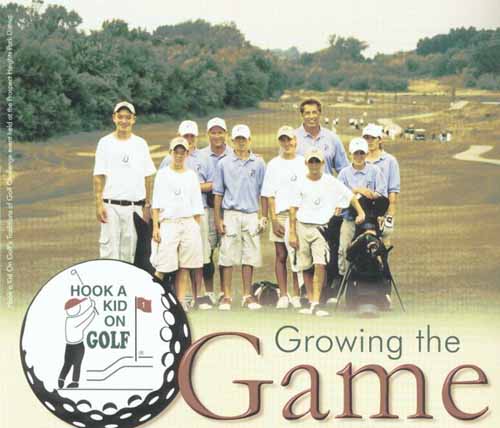 |
Home | Search | Browse | About IPO | Staff | Links |
 |
Home | Search | Browse | About IPO | Staff | Links |
|

Junior golf can boost a stagnant golf program By Holly Alcala To the avid golfer or industry outsider it may seem that the sport of golf is growing exponentially. Golf courses are popping up everywhere. Courses seem busy and it may be a little harder to get a tee time than in years past. However, the reality is that by most accounts and according to experts, the sport of golf and the numbers of participants are stagnant. There is a high level of interest in the game however the industry has not been able to capitalize on it. Introducing thousands of children and adults to golf does present some challenges, which golf course owners, operators and program administrators face now and in the future. In order to meet the challenges and to prepare for them, an industry-wide initiative was started a few years ago called Golf 20/20. The mission of Golf 20/20 is to "align the golf industry behind a plan that addresses the future of golf in a strategic manner, with an emphasis on accelerating growth and participation, and creating new avenues of access into the game." The Golf 20/20 effort is looking at the industry and creating initiatives that will have an immediate impact on the game but is also focused on long-term goals and initiatives that will take the game to 32 Illinois Parks and Recreation
where they would like it to be by the year 2020. According to a consumer research report conducted by Golf 20/20 in November of 2001, there are more than 36 million golf participants in the United States. Of the 36 million, 4 million are classified as junior golfers ages 5 to 17 years. The report found that current golfers ages 18 to 34 who participated in a junior golf program are playing 58 percent more rounds and spending 71 percent more on greens fees and equipment compared to those golfers who did not participate in a junior golf program. The report also shows that the growth in junior golf is almost all coming from junior boys, while participation by girls is flat. Some of the barriers that were identified that keep children from participating in the sport include no one to play with, need to play better, affordability and time. Along with introducing the basic fundamentals to newcomers, to enable them to swing, putt, and play, many organizations and individuals believe that the sport and its unique history, etiquette and rules can help instill positive values, life lessons, and character-building traits. Junior golf programs such as Hook A Kid On Golf are reaping the benefits of this golf boom, as well as feeling the pressure to keep kids involved. In the year 2001, the Hook A Kid On Golf program in Illinois had 40 different organizations involved in the program. That number grew to over 80 in 2002. Programs such as Hook A Kid On Golf can introduce golf to youngsters and give them the tools to be successful in the sport. Marc Heidkamp, director of golf at the Prospect Heights Park District has adopted the entire Hook A Kid On Golf program and has found success with it.
"The best things about the Hook A Kid On Golf program is that it provides you with a curriculum and materials to follow," says Heidkamp. "I did not have a junior golf program prior to adopting Hook A Kid, now I have several hundred kids in the program." Challenges still remain; for example, continued play and practice opportunities are difficult to find and golf can be expensive. Findings from Golf 20/20 suggest two key areas concerning the growth of the game of golf. First, affordability. Consumer research shows that golfers want prices between $25 and $55, but most of the golf course construction over the last several years has focused on building upscale, high-end, more difficult golf courses with green fees priced higher than that range. Thus, the development of more 9-hole facilities, shorter, beginner-friendly golf courses will be important to the growth of the game. Not only will these courses be more affordable, but it will take less time for a golfer, child or adult to play a round. A second key to the future of golf is the proliferation of structured junior golf programs. Park district and recreation departments should be able to capitalize on the junior golf boom by offering more structured golf programs. Adopt or create additional levels to the existing lesson structure to help develop the golfer and create programming for the whole family where a mother, father and children can participate together. And, finally, simply make golf affordable and fun.
Holly Alcala

March/April 2003 33 |
|
|